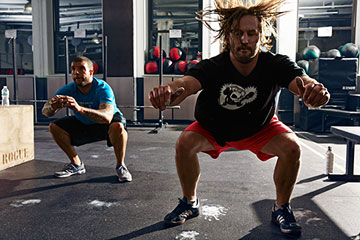
CrossFitters work out in a New York City box. CrossFit preaches constantly varied, high-intensity, functional movement.
(4 of 5)
In September, Eric Robertson, a professor of physical therapy at Regis University in Denver, posted an article about rhabdo on Medium.com headlined CrossFit's dirty little secret. Robertson wrote, "Rhabdomyolysis isn't a common condition, yet it's so commonly encountered in CrossFit that they have a cartoon about it." CrossFitters jumped all over him; he shut down his Facebook account. "It was everything from You're a troll, you're an idiot, you don't know what you're talking about," Robertson says. "It was nasty all the way through."
On Twitter, Berger called Robertson's article a "dishonest hit piece" and badgered Robertson to publicly debate him. After Good Morning America interviewed Robertson for a segment on rhabdo, someone made a spoof of it titled "CrossFit Threatens America." With Robertson onscreen, a voice dubbed over his actual comments. "With exercise comes risk," it said. "That's why I've never exercised once in my life." The narrator belittles an actual rhabdo victim shown onscreen. CrossFit sent out the spoof from its Twitter feed.
Some doctors and physical therapists are reporting plenty of other CrossFit injuries. Joe Terry, a physical therapist in Peoria, Ill., has seen a steady stream of CrossFit-induced ailments ranging from knee and pelvic pain to herniated disks to lumbar stress fractures, which cause severe lower-back pain. Buyer beware, says Terry. Make sure your trainer is well versed in proper weight-lifting form. "Certain gyms tend to have healthier clients than others," says Terry. "Make educated decisions. Don't be more concerned about beating your time or increasing your rounds than listening to your body."
The scientific evidence is inconclusive. One study, to be published in the Journal of Strength and Conditioning Research, surveyed CrossFitters across global online forums: 97 of the 132 respondents, or 73.5%, said they suffered an injury that prevented them from "working, training or competing." Nine, or 7%, said their injuries required surgery. The average period of CrossFit training was 18.6 months; no rhabdo cases were reported. The authors conclude that CrossFit has injury rates broadly similar to those of activities like Olympic weight lifting, power lifting, gymnastics, distance running and triathlon training, but they also acknowledge the study's potential self-selection bias, "with athletes who have had an injury being more likely to participate."
Yet Yuri Feito, an exercise-science professor at Kennesaw State University in Georgia, has compiled data that have yet to be published or peer-reviewed that found that although half of his 733 respondents suffered some kind of CrossFit injury, 85% of the injuries were mild-- things like abrasions and minor sprains. "That surprised me," says Feito. "I was expecting to see some more severe injuries, given the nature of the program." Feito found three cases of rhabdo.
